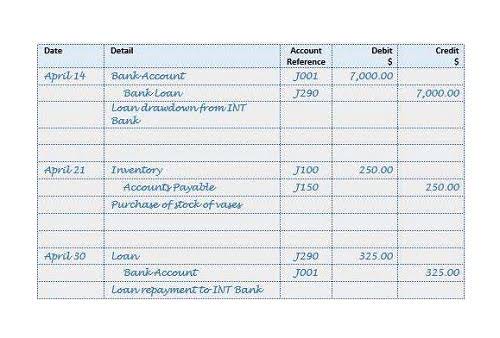Content

Each journal entry is transferred from the general journal to the corresponding T-account. The debits are always transferred to the left side and the credits are always transferred to the right side of T-accounts. In Section 2.3 we recorded the consequences of these transactions in a balance sheet for Edgar Edwards Enterprises dated 6/7/20X2. As there were only six transactions, it was probably not too difficult. However, many enterprises have to record hundreds of transactions per day.

In this glossary, we’ll explore the key terms and concepts related to double-entry accounting, complete with examples. By understanding these essential terms, you’ll be better equipped to manage your business finances and make informed decisions. You notice there are already figures in Accounts Payable, and the new record is placed directly underneath the January 5 record. On this transaction, Accounts Receivable has a debit of $1,200. The record is placed on the debit side of the Accounts Receivable T-account underneath the January 10 record. The record is placed on the credit side of the Service Revenue T-account underneath the January 17 record.
Financial and Managerial Accounting
If the debit side and credit side of the trial balance are equal, it is proved that the account books are arithmetically correct. But, with business needs becoming more diverse, financial statements are needed to be in alignment with business health and funding so that effective decisions can be made. This is also a more efficient, reliable, accurate way of recording transactions digitally while saving effort, time, resources, and more.

This graphic representation of a general ledger account is known as a T-account. A T-account is called a “T-account” because it looks like a “T,” as you can see with the T-account shown here. A T-account is a casual term for a set of monetary records that utilizations twofold entry accounting.
How to Post Journal Entries to T-Accounts or Ledger Accounts
Due to its simplistic nature, T-accounts are also used as a learning tool to practice transactions and double-entry accounting. They can be found drawn on a scrap piece of paper to templates made in accounting software. T Accounts are also used for income statement accounts as well, which include revenues, expenses, gains, and losses. Debits and Credits are simply accounting terminologies that can be traced back hundreds of years, which are still used in today’s double-entry accounting system. When most people hear the term debits and credits, they think of debit cards and credit cards.
The record is placed on the credit side of the Accounts Receivable T-account across from the January 10 record. This is posted to the Cash T-account on the credit side beneath the January 14 transaction. Accounts Payable has a debit of $3,500 (payment in full for the Jan. 5 purchase). You notice there is already a credit in Accounts Payable, and the new record is placed directly across from the January 5 record.
Step 4: Final Answer
Small business owners, accountants, or bookkeepers accustomed to double-entry-style accounting use this tool, which can serve as a powerful graphic aid to ensure accounts balance out. A balance sheet is a summary of a company’s financial position at a given point in time. The balance sheet summarizes the financial position of the company at the end of a specific period, usually at the end of the fiscal year. It is used by stakeholders to evaluate a company’s financial strength and to make investment decisions. T-accounts can display transactions from a specific time period such as a week or a month. By displaying multiple transactions over a time period rather than a single transaction, it allows people to see a picture of a company’s activities.
Credit sales of things other than the goods dealt in by the firm are not entered in the Sales day Book; they are journalised. We can illustrate each account type and its corresponding debit and credit effects in the form of an expanded accounting equation. It has columns for the date of a transaction, any what are t accounts special notations (Item), a debit and credit column (like the T-Account), and a running balance for the account. A T-account is shaped like the letter T and has a debit (left) column and a credit (right) column. It is used as a visual way to demonstrate increasing and decreasing accounts in accounting.
Using Accounts Payable T-Accounts for Spend Accountability
In other words, it is the amount of money that would be left if all assets were sold, and all liabilities were paid off. Streamline your double-entry accounting process with Wafeq’s easy-to-use and powerful accounting software. You can see that a journal has columns labeled debit and credit. The debit is on the left side, and the credit is on the right. If you’re ready to automate the entire accounting process for your small business, be sure to check out The Ascent’s accounting software reviews. When you’re ready to use T-accounts, you can use them separately, in order to view journal entry details, or you can enter the transaction directly into your journal.
T-accounts should be used whenever you need to track the changes in an account’s balance. This can be during the normal course of business or when preparing adjusting entries at the end of an accounting period. T-accounts can be a useful resource for bookkeeping and accounting novices, helping them understand debits, credits, and double-entry accounting principles.
Where is T-Accounts Commonly Used
Asset account balances and expenses are on the accounts’ left side. The liabilities, stockholders’ equity and revenue balances are on the right side. A real account is one that is carried forward and it isn’t closed at the end of the year. In effect, a debit increases an expense account in the income statement and a credit decreases it.
- This is also a more efficient, reliable, accurate way of recording transactions digitally while saving effort, time, resources, and more.
- In a double-entry accounting system, each transaction is recorded in at least two different types of accounts, such as assets, liabilities, owner’s equity, revenue, and expenses.
- The left side of any t-account is a debit while the right side is a credit.
- As you can see, there is one ledger account for Cash and another for Common Stock.
- This can be during the normal course of business or when preparing adjusting entries at the end of an accounting period.